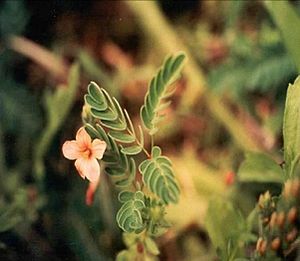Slender rushpea facts for kids
Quick facts for kids Slender rushpea |
|
|---|---|
 |
|
| Conservation status | |
| Scientific classification | |
| Kingdom: | |
| (unranked): | |
| (unranked): | |
| (unranked): | |
| Order: | |
| Family: | |
| Genus: |
Hoffmannseggia
|
| Species: |
H. tenella
|
| Binomial name | |
| Hoffmannseggia tenella Tharp & L.O.Williams
|
|
The Hoffmannseggia tenella is a very rare flowering plant. People often call it the slender rushpea. It belongs to the legume family, which includes peas and beans. This special plant only grows in Texas, in just two counties. It lives in small parts of its natural home, which is a type of coastal prairie. Because it is so rare, the United States government lists it as an endangered species. This means it needs special protection to survive.
Contents
What the Slender Rushpea Looks Like
The slender rushpea is a small plant. It grows up to 15 centimeters (about 6 inches) tall. It has a strong, woody taproot that helps it get water. Sometimes, many of these plants grow together in groups.
Its leaves can be up to 6 centimeters long. Each leaf has 5 to 7 pairs of smaller leaves called leaflets. The flowers are tiny, about half a centimeter long. They come in pretty colors like yellowish-pink, orange, coral, or salmon. The plant usually blooms from March to June. If there is enough rain, it might even bloom again later in the year. After blooming, it grows a flat, straight legume pod. This pod is just over a centimeter long and holds the plant's seeds.
Where the Slender Rushpea Lives
You can only find the slender rushpea in Nueces and Kleberg Counties in Texas. Its natural home is a type of shortgrass prairie near the coast. This area is full of native grasses. Some of these grasses include buffalograss (Buchloe dactyloides), Texas wintergrass (Stipa leucotrica), and Texas grama (Bouteloua rigidiseta).
Other Plants in its Home
Many other plants share the slender rushpea's habitat. These include thorny bushes and cacti. Some examples are huisache (Acacia farnesiana), huisachillo (Acacia schaffneri), and spiny hackberry (Celtis laevigata). You might also see brasil (Condalia hookeri), retama (Parkinsonia aculeata), and lotebush (Ziziphus obtusifolia). Cacti like tasajillo (Opuntia leptocaulis) and Engelmann's prickly pear (Opuntia engelmannii) also grow there. Sometimes, the slender rushpea grows next to another endangered plant called the South Texas ambrosia (Ambrosia cheiranthifolia).
Why the Slender Rushpea is Endangered
The slender rushpea has lost most of its home. It now grows in only about 15% of the area it used to cover. Most of its land has been turned into farms for crops or pastures for animals.
Threats from Other Plants
Another big problem for the slender rushpea is non-native plants. These are plants that were brought to Texas from other places. They grow very fast and compete with the rare rushpea. The worst of these is a large grass called Kleberg bluestem (Dichanthium annulatum).
Kleberg bluestem grows quickly and gets very tall. It shades out the small slender rushpea, blocking its sunlight. This dense grass can also trap heat and humidity. This warm, wet environment can cause fungi to grow on the rushpea's young plants, called seedlings. The bluestem also takes away important nutrients and water from the soil. It might even release chemicals that stop the rushpea from growing well. All these things make it very hard for the slender rushpea to survive.


